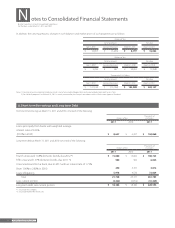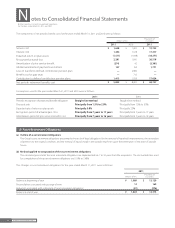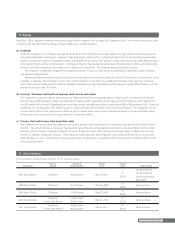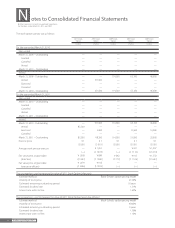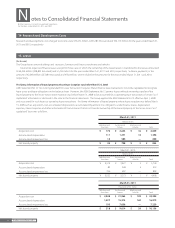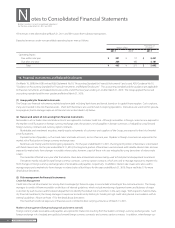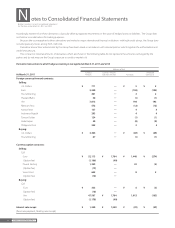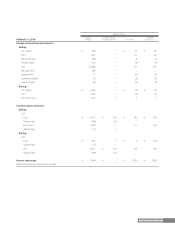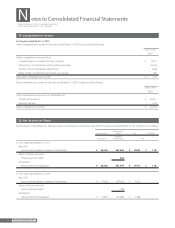Brother International 2011 Annual Report Download - page 42
Download and view the complete annual report
Please find page 42 of the 2011 Brother International annual report below. You can navigate through the pages in the report by either clicking on the pages listed below, or by using the keyword search tool below to find specific information within the annual report.
Brother Industries, Ltd. and Consolidated Subsidiaries
For the Years ended March 31, 2011 and 2010
40 Brother Annual Report 2011
All revenues in the above table at March 31, 2011 and 2010 arose from sublease transactions.
Expected revenues under noncancellable operating leases were as follows:
Millions of Yen
Thousands of
U.S. Dollars
2011 2010 2011
Operating leases:
Due within one year ¥ 201 ¥97$ 2,421
Due after one year 264 180 3,181
Total ¥ 465 ¥ 277 $ 5,602
16. Financial Instruments and Related Disclosures
On March 10, 2008, the ASBJ revised ASBJ Statement No.10, “Accounting Standard for Financial Instruments” and issued ASBJ Guidance No.19,
“Guidance on Accounting Standard for Financial Instruments and Related Disclosures.” This accounting standard and the guidance are applicable
to financial instruments and related disclosures at the end of the fiscal years ending on or after March 31, 2010. The Group applied the revised
accounting standard and the new guidance effective March 31, 2010.
(1) Group policy for financial instruments
The Group uses financial instruments, mainly long-term debt including bank loans and bonds, based on its capital financing plan. Cash surpluses,
if any, are invested in low risk financial assets. Short-term bank loans are used to fund its ongoing operations. Derivatives are used, not for specula-
tive purposes, but to manage exposure to financial risks as described in (2) below.
(2) Nature and extent of risks arising from financial instruments
Receivables such as trade notes and trade accounts are exposed to customer credit risk. Although receivables in foreign currencies are exposed to
the market risk of fluctuation in foreign currency exchange rates, the position, net of payables in foreign currencies, is hedged by using forward
foreign currency contracts and currency option contracts.
Marketable and investment securities, mainly equity instruments of customers and suppliers of the Group, are exposed to the risk of market
price fluctuations.
Payment terms of payables, such as trade notes and trade accounts, are less than one year. Payables in foreign currencies are exposed to the
market risk of fluctuation in foreign currency exchange rates.
Bank loans are mainly used to fund ongoing operations. For the year ended March 31, 2011, the long-term portion of bank loans is borrowed
with fixed interest rate. For the year ended March 31, 2010, the long-term portion of bank loans was borrowed with variable interest rates and was
exposed to market risks from changes in variable interest rates, however, a part of those risks was mitigated by using derivatives of interest-rate
swaps.
The maturities of bonds are a year after the balance sheet date at maximum and are mainly used to fund plant and equipment investment.
Derivatives mainly include forward foreign currency contracts, currency option contracts, which are used to manage exposure to market risks
from changes in foreign currency exchange rates of receivables and payables, respectively. In addition, interest-rate swaps were also used to
manage exposure to market risks from changes in interest rates of bank loans for the year ended March 31, 2010. Please see Note 17 for more
detail about derivatives.
(3) Risk management for financial instruments
Credit Risk Management
Credit risk is the risk of economic loss arising from counterparty’s failure to repay or service debt according to the contractual terms. The Group
manages its credit risk from receivables on the basis of internal guidelines, which include monitoring of payment terms and balances of major
customers by each business administration department to identify the default risk of customers in the early stage. With respect to held-to-matu-
rity financial investments, the Group manages its exposure to credit risk by limiting its funding to high credit rating bonds in accordance with its
internal guidelines. Please see Note 17 for the detail about derivatives.
The maximum credit risk exposure of financial assets is limited to their carrying amounts as of March 31, 2011.
Market risk management (foreign exchange risk and interest rate risk)
Foreign currency trade receivables and payables are exposed to market risk resulting from fluctuations in foreign currency exchange rates. Such
foreign exchange risk is hedged principally by forward foreign currency contracts and currency option contracts. In addition, when foreign cur-
Notes to Consolidated Financial Statements




